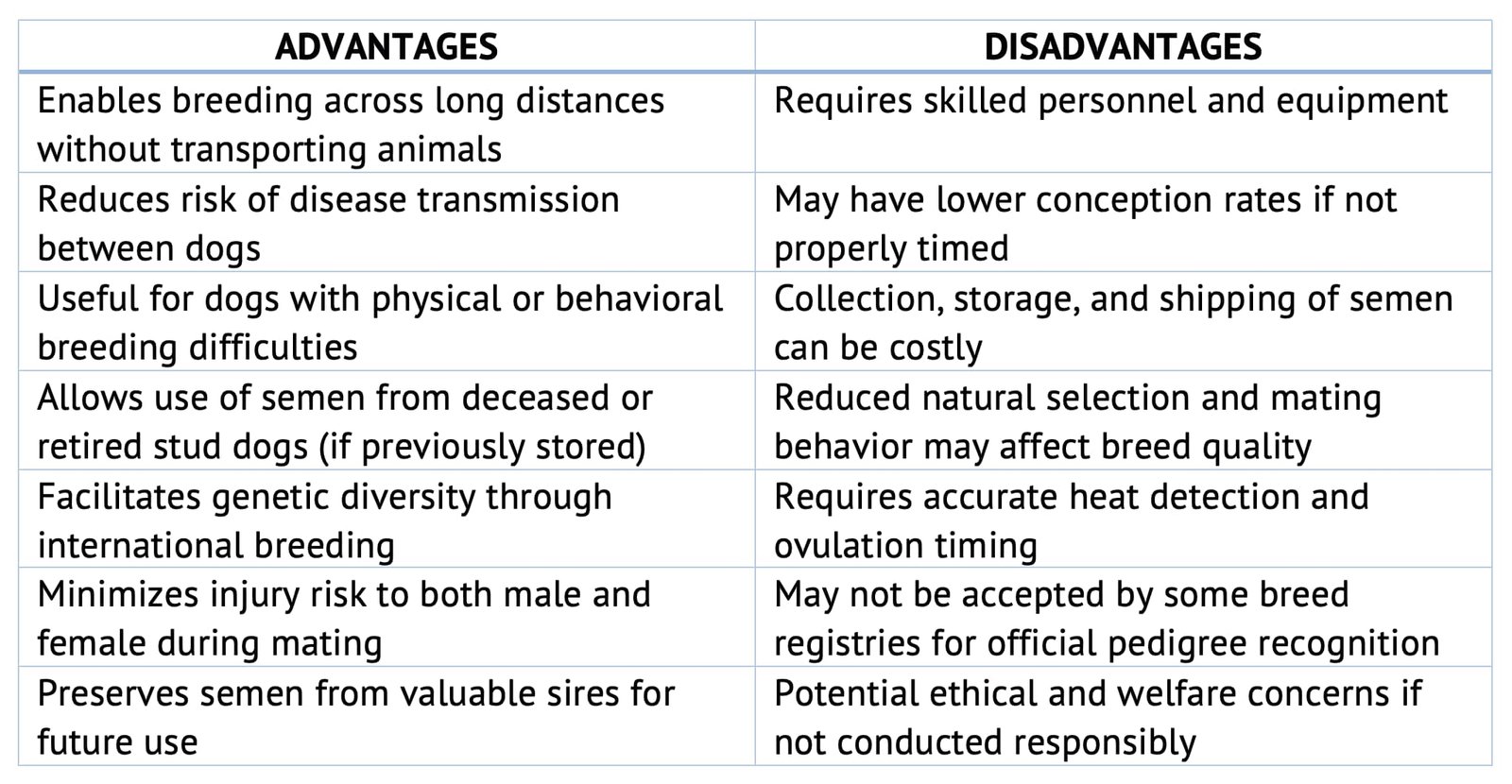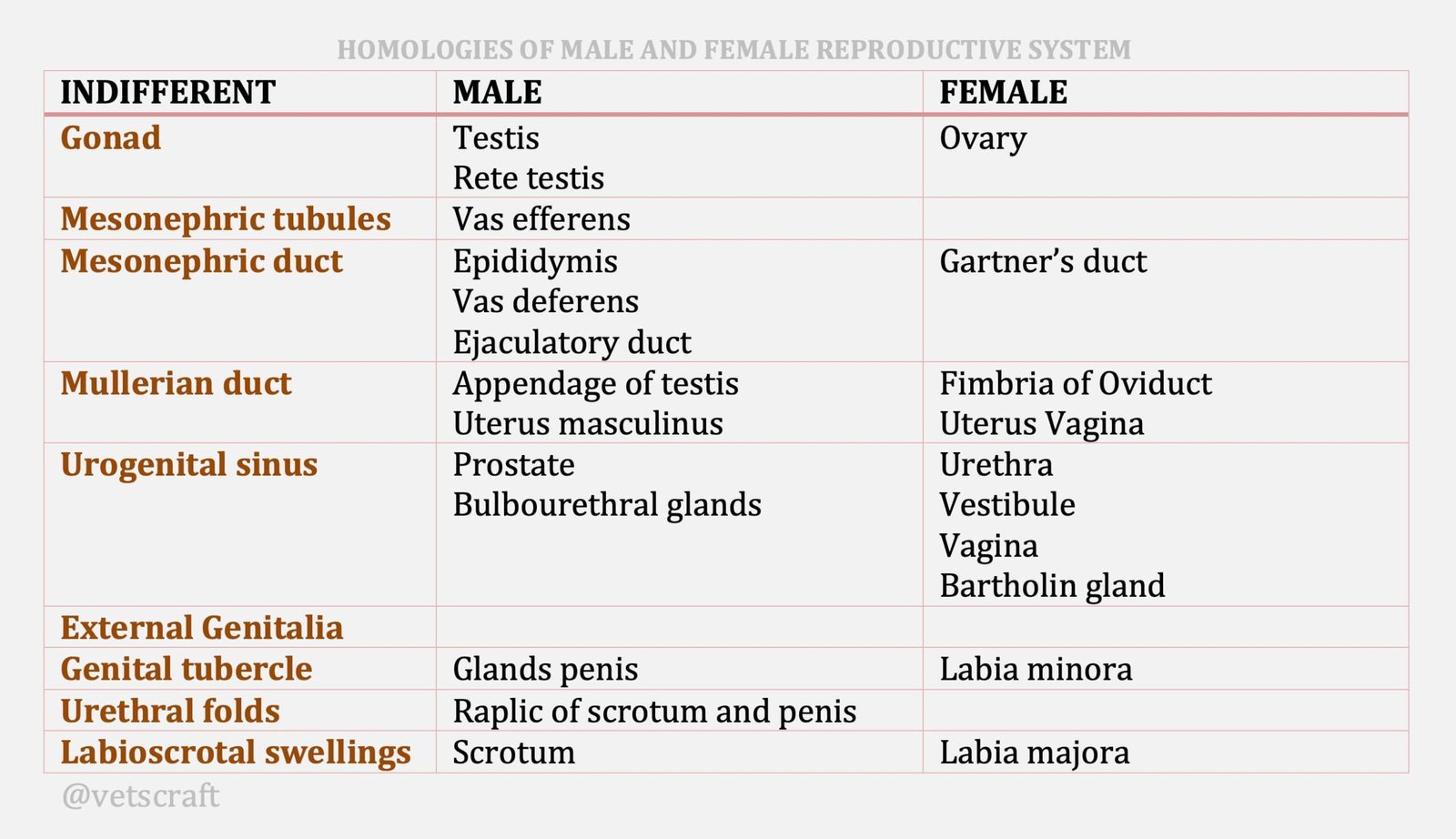TABLE OF CONTENTS
Artificial Insemination (AI) in Dogs
Artificial Insemination (AI) in dogs is a reproductive technique used to deposit semen into the female’s reproductive tract without natural mating.
The manual collection and subsequent deposition of semen into the vaginal vault of a bitch in estrus is a common procedure used by breeders and veterinarians.
As a result, artificial insemination is frequently requested by the dog owner or handler. Fresh undiluted semen, semen mixed with an extender, or frozen semen is used in dogs.
To enhance changes of success, veterinarians must have a good understanding of the estrus cycle, semen collection and AI techniques, and potential pitfalls that may be encountered.
Indications for Artificial Insemination
There are several situations in which AI may be used. They are:
- For the bitch, these problems include:
- vaginal strictures
- conformational defects
- rear leg weaknes
- psychological problems
- pain
- for the male:
- weakness
- arthritis
- back pain
- premature ejaculation
- conformational defects that prevent intromission or a “tie”.
AI may also be chosen because of a major size difference between the mates. Psychological problems may also result in the need for AI.
Some owners wish to use AI avoid any possible venereal contact between their dog and its mate, thereby controlling the spread of potentially infectious diseases.
Inseminating semen into the vagina still provides intimate contact between bitch and stud dog and therefore any infectious agent that could be transmitted from the dog to the bitch during natural mating also has the potential to be transmitted during AI.
However AI does avoid transmission of infectious agents from the bitch to the stud dog. All breeding dogs and bitches should be Brucella-free as determined by appropriate tests.
Some male dogs experience prostatic bleeding and hemospermia following exposure to a bitch “in heat”. The bleeding may be associated with Von Willebrand‘s disease (VWD) but has also been observed in dogs not afficted with VWD. Regradless, AI can be performed without any contact between stud dog and bitch, occasionally avoiding this problem.
Fresh extended and frozen forms of semen are being used with increasing frequency. Because semen collection is the difficult task, insemination of extended or previously frozen semen remains a relatively simple procedure.
The shipment and use of fresh, extended or frozen semen helps defray the cost and removes the hazards associated with shipping the female.
Artificial Insemination by Fresh Semen
Insemination Procedure
Although there are a variety of “tools” used for insemination, commonly used tools are:
- 12 ml syringe
- Flexible disposable male urinary catheter or rigid plastic insemination pipette or the Cassous AI sheath
- Surgical gloves
These items should be sterile. After the gloves are put on, the semen sample is drawn into the syringe, the sterile catheter is attached, and the syringe is then filled with an additional 1 to 3 ml of air.
A gloved, non lubricated index finger is placed into the vaginal vault, palm up. If a lubricant is used it must be nonspermicidal.
The catheter is then slid over the top of the finger and passed into the vaginal vault, avoiding accidental catheterization of the urethra. Sliding the catheter over the index finger also aids in avoiding the clitoral fossa.
The catheter follows the dorsal curvature of the vaginal vault.
The catheter is inserted until resistance is met. The resistance indicates that the cranial end of the vagina vault has been reached or the catheter has simply become trapped within vaginal folds.
The catheter should be gently advanced as far cranially as possible before the semen is deposited to ensure deposition of spermatozoa near the cervix and into the uterus.
Once the syringe containing the semen has been emptied it should be disconnected from the catheter, filled with a few more milliliters of air, reattached to the catheter, and emptied, thereby depositing any semen that may have remined in the catheter.
Care should be taken to avoid injecting too much air into the vagina, as this may result in loss of semen out of the vulva once the procedure is completed.
Once the semen has been deposited, the catheter should be removed and the hindquarters of the bitch should remain elevated above her head for a minimum of 20 minutes, thereby aiding the movement of semen anteriorly in the reproductive tract and into the uterus.
Insertion of a gloved finger and the gentle stroking of the dorsal wall of the vagina during this time may stimulate muscular contractions within the reproductive tract, further enhancing the movement of spermatozoa toward the ovaries.
After elevation of the hindquarters has been completed, the bitch should be kept quiet for an hour or so to minimize loss of semen out of the vagina. In addition, pressure should not be applied to the abdomen.
The entire insemination procedure is rarely a problem for the bitch. There should not be any pain or discomfort associated with the procedure. For these reasons, the procedure is rather simple and not time consuming.
Semen that has been properly extended and chilled can be refrigerated for several days yet still yield fertile sperm when warmed and inseminated.
The extender helps keep the spermatozoal membranes from being harmed by changes in temperature or shaking during transport, while also providing nutrients and stabilizing the pH of the medium.
Semen once extended, is gradually cooled to 5 to 15°C over a period of 30 to 60 minutes.
Rapid changes in temperature must be avoided. When prepared properly, chilled extended spermatozoa easily remain viable for 24 hours and, depending on the technique, may remain viable for as long as 5 days.
Sort-term preservation of sperm allows overnight air delivery of freshly extended semen without the costs of frozen semen or shipment of the bitch.
The ejaculate is extended, packaged in a small container, and shipped in a thermostype container. The ejaculater, should remain cold during shipment and should be kept refrigerated until use.
The technique for insemination of the bitch with extended semen is as previously described for insemination with fresh semen.
Ideally, multiple inseminations beginning 3 to 4 days after the initial rise in blood progesterone concentration should be completed to maximize conception rate.
Artificial Insemination by Frozen Semen
Long-term preservation of semen utilizing deep freezing techniques has been available for several years.
The advantages of using frozen semen include:
- Wider dispersion of desirable genetic traits
- Disease prevention
- Decreased numbers of breeding males in research colony
- Preservation of semen from dogs with diseases that are models of human disorders
- Elimination of the need for shipping bitches
The steps involved in freezing semen for AI include:
- Semen collection
- Dilution in an extender
- Equilibration under refrigeration
- Freezing in convenient volumes
- Storage
- Thawing and insemination of the bitch during the peak of her fertile period
Extenders such as egg yolk, glycerol, lactose, skim milk and antibiotics are typically added to the semen prior to freezing. Extenders have:
- Nutrients as an energy source
- Buffer against harmful changes in pH
- Provide a physiologic osmotic pressure and concentration of electrolytes
- Prevent growth of bacteria
- Protect cells from cold shock during the cooling process
- Have cryoprotectants that reduce sperm cell damage during freezing and subsequent thawing
Canine sperm is often frozen in 0.5 ml, plastic “French straws.” Straws provide a convenient format for handling, labeling, storage and thawing.
Alternative formats include bulk semen volumes sealed in ampoules and semen frozen in small spherical pellets on a block of dry ice.
Frozen semen has been stored for as long as 9 years with little to no post-thaw decrease in sperm motility. More than 4 years have been reported between semen collection/storage and thawing/conception. Thawing instructions usually accompany the semen and should be followed exactly.
At the time of insemination, small drop of thawed semen should be evaluated microscopically for sperm viability and motility.
Advantages and Disadvantages of Artificial Insemination (AI) in Dogs


